Part of a series of articles titled Alaska Park Science - Volume 16 Issue: Science in Alaska's Arctic Parks.
Article
Collaborative Conservation of the Rare Alaskan Yellow-billed Loon
By Melanie Flamme and Stacia Backensto, National Park Service
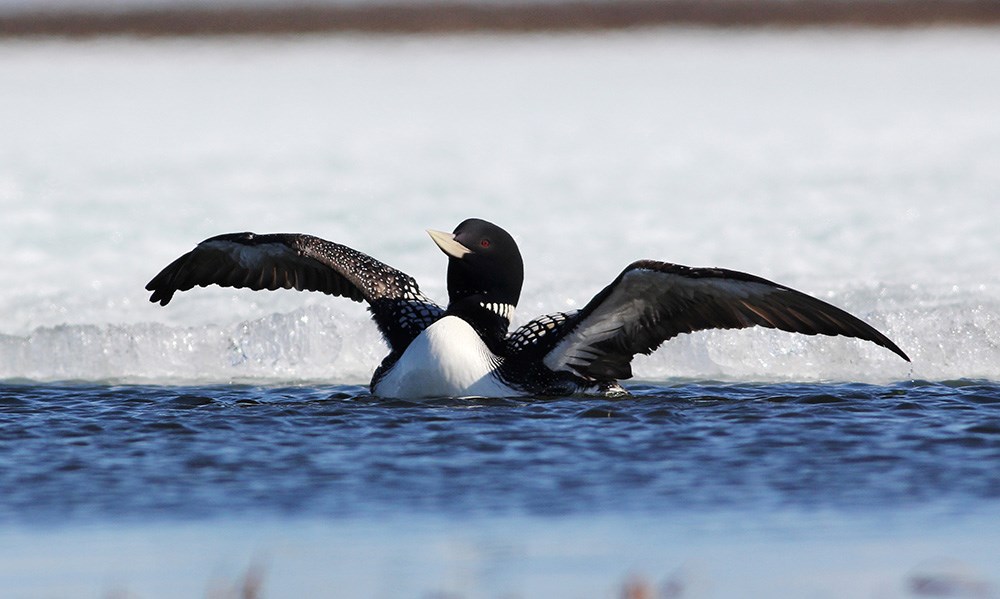
Courtesy Cameron Rutt, Wildlife Conservation Society
Approximately 1,500 Yellow-billed Loons are estimated to nest in Bering Land Bridge National Preserve and Cape Krusenstern National Monument, coastal parklands that may offer more protections for the birds and their nesting habitat (Figure 1). Yellow-billed Loons of the Seward Peninsula differ from those of the Coastal Plain in that they frequently use marine habitats for foraging (Schmutz et al. 2014), making them especially vulnerable to exposure to an oil spill with the recent growth in oil exploration and vessel traffic in the region.
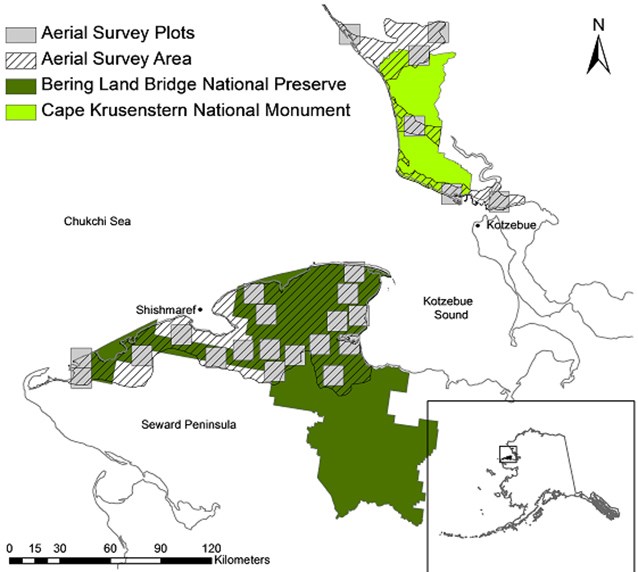
Looking at the Long-term Picture with Monitoring
Since 2005, we have worked with the U.S. Fish and Wildlife Service (USFWS) to monitor Yellow-billed Loons in Bering Land Bridge and Cape Krusenstern to document long-term population trends. Though the surveys are designed for and focused on detecting Yellow-billed Loons, we collect data on all species of loons observed. To conduct these surveys, we work with experienced loon surveyors, pilot and biologist Nikki Guldager and biologist Tamara Zeller from the USFWS.
Based on aerial surveys conducted in 2011 and 2013 across both parks, Alaska’s northwestern breeding population of Yellow-billed Loons is about 2-2.5 times larger than previously thought (Figure 2). The birds nested at 205 lakes and used an additional 207 of 1,291 lakes in the study area (Schmidt et al. 2014). The likelihood these same lakes would be used in subsequent years was high (greater than 70%), suggesting strong nest site fidelity for particular lakes. Similar species, like Pacific Loons (Gavia pacifica), often require the same lake habitat for nesting and may compete with Yellow-billed Loons. We found that even though Pacific Loons were more likely to use lakes in the study area, in some cases they were excluded from doing so by Yellow-billed Loons. Competition between these two species occurs to a greater degree on the Coastal Plain (Haynes et al. 2014).
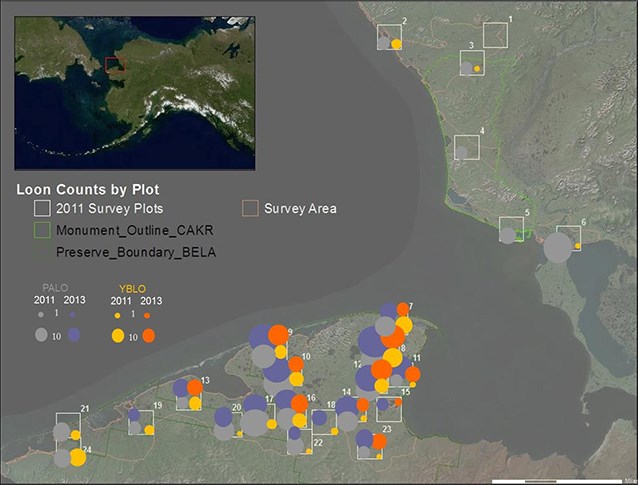
Further, our research shows that Yellow-billed and Pacific loons in both parks are using a broader area of lake habitats during the breeding season for both nesting and foraging than previously thought. More study is needed to understand why these species select specific lakes while protecting a broader area around them. Such information will be an essential consideration for the conservation of these species. Overall, our results suggest that Bering Land Bridge and Cape Krusenstern may support significant populations of both species, warranting additional consideration for conservation.
To evaluate the health of the birds and the aquatic systems they use, we monitor the types and levels of contaminants burdens found in eggs and small prey fish from their nesting lakes. Analysis of eggs provides a signature of contaminants the adults are exposed to when off their breeding grounds. We analyze prey fish to provide information on the types and levels of local contaminants present on the breeding grounds. To conduct this work, we work with researchers Dr. Angela Matz (Chief of the USFWS Ecological Contaminants Program) and Debbie Nigro (Primary Investigator of the Bureau of Land Management’s (BLM) Yellow-billed Loon research on the Coastal Plain).
Environmental contaminants we analyze include: metals (e.g., mercury), persistent organic pollutants (POPs), organochlorine pesticides, perfluorinated hydrocarbons, polychlorinated biphenyl (PCB) congeners, and polybrominated diphenyl ethers.
Our preliminary results from egg samples suggest that mercury may be approaching levels that could impede reproduction in Yellow-billed Loons nesting in these parks; similar results were detected in eggs from the Coastal Plain (Matz et al. 2006). Currently, we are comparing data from these northwestern Alaska parklands to data collected from birds on the Coastal Plain to assess the types and levels of contaminants burdens present across the entire population of Yellow-billed Loons in Alaska. We will continue to collect data from egg samples and prey fish to get a more thorough understanding of contaminants and their long-term impacts on Yellow-billed Loons.
A View from Above: Remote Sensing Studies Assess Habitat for Fish and Loons
We know very little about what lake characteristics (type, connectivity, depth, and flood regimes) are preferred by Yellow-billed Loons in northwestern Alaska. Freshwater fish distributions in Arctic lakes are an important determinant in nest-site selection for these piscivorous birds, and yet these data also are lacking (Ernst et al. 2006, Haynes et al. 2014). To address these data gaps, we work with Dr. Ben Jones at the U.S. Geological Survey (USGS) and Dr. Chris Arp at the University of Alaska-Fairbanks to identify characteristics of freshwater lakes in Bering Land Bridge that provide important winter habitats for fish. We are using remote sensing and high-resolution satellite imagery, space-borne synthetic aperture radar (ifSAR) imagery, ice-growth models, and weather station data to develop a geospatial database of lake type, connectivity, depth, and flood regimes (Arp et al. 2011, Jones et al. 2013). By analyzing winter and spring ifSAR imagery of hundreds of lakes in the park, we can estimate lake depths to identify areas that remain partially unfrozen throughout the year. These areas may serve as important overwintering areas vital for fish, and thus, are attractive to loons. These data can then be used to develop habitat-selection models for Yellow-billed Loon nesting and direct future sampling of environmental DNA (eDNA) to assess fish distributions in these parklands. This research is currently underway and is slated for completion by late 2017.
Diving Deeper with Genetics Research
Genetic tools can help us understand more about fish distributions and the relatedness of Yellow-billed Loon populations in Bering Land Bridge and Cape Krusenstern to other populations. We collected water samples from Yellow-billed Loon nesting lakes and analyzed them for eDNA (trace fragments of DNA shed from organisms in the lakes that can provide a picture of the lakes’ biodiversity). Often, the eDNA samples can be linked to a specific species of fish or loon present in the lake or, more coarsely, to the level of the genus or family.
We also use DNA swabs to collect shed adult epithelial cells and maternal blood (from egg-laying) from the surface of Yellow-billed Loon eggs. Because both parents brood the eggs, this less-invasive method allows us to collect DNA samples from the pair without handling the adult birds. From the DNA extracted from the egg swabs, we developed a suite of over 20 polymorphic microsatellite markers for Yellow-billed Loons that are used to generate specific genotypes of each bird for individual identification. These data can be used not only to develop a DNA fingerprint (specific genotype) for each bird, but can also help us confirm fidelity of pairs returning to the same nest sites each year and explore family relationships, such as paternity.
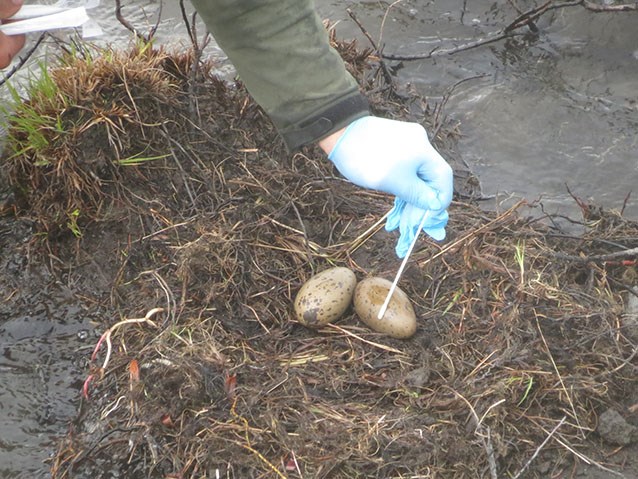
NPS Photo / Melanie Flamme
Preliminary results indicate Yellow-billed Loons have lower levels of genetic variation than other species of loons, both in allelic variation and levels of heterozygosity (Talbot et al. 2014). Initial analyses of the eDNA samples taken from Yellow-billed Loon nesting lakes have detected the presence of many fish species as well as Yellow-billed Loons (Talbot 2014, pers. comm.). Research for both projects is ongoing. When combined with the ifSAR geodatabase as a guide for future sampling locations, the eDNA could prove to be a powerful tool to assess the presence and distributions of fish and loons in additional waterbodies throughout these parklands.
Conservation: It Takes Collaboration
In combination, these studies (aerial surveys, contaminants analyses, ifSAR geodatabase of fish distribution and lake characteristics, and eDNA and Yellow-billed Loon population genetics) provide missing pieces of information that help us develop a clearer picture of the population status of Yellow-billed Loons in Bering Land Bridge and Cape Krusenstern. Together, through collaborative research with our partners, we are addressing the data gaps outlined in the Status Assessment and Conservation Plan for the Yellow-billed Loon (Ernst 2004) to inform prudent conservation efforts and science-based management of this rare and majestic species across Alaska.
Sharing the Yellow-billed Loon Story through Youth Engagement
Since 2013, we have recruited five students from urban and rural Alaska to participate in video production at the Alaska Teen Media Institute (ATMI) to learn the craft of video storytelling. Our goal was to have the students tell the story of Yellow-billed Loons from a youth perspective. The students traveled with scientists to Bering Land Bridge, Cape Krusenstern, the village of Inigok in the National Petroleum Reserve, and the Helmrick’s homestead on the Colville River to experience the loons in their habitat, learn about scientific studies of loons, and collect video footage.
Through partnerships with ATMI, Shishmaref School, West High School, Effie Kokrine Early College Charter School, the Wildlife Conservation Society, USFWS, BLM, and funding from Alaska Geographic and Murie Science and Learning Center grants, the students created three compelling videos about Yellow-billed Loons that resonate with their communities and other youth.
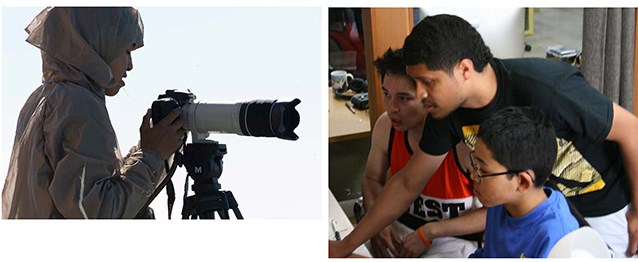
NPS Photos / Dev Dharm Khalsa and Stacia Backensto
- Alaska’s Yellow-billed Loons (2014)
- Telling a Loon Story: An Alaskan youth filming expedition in Bering Land Bridge National Preserve (2013)
- Filming Alaska’s Yellow Billed Loons: A Youth Experience (2013)
References
Arp, C. D., B. M. Jones, F. E. Urban, and G. Grosse. 2011.
Hydrogeomorphic processes of thermokarst lakes with grounded-ice and floating-ice regimes on the Arctic coastal plain, Alaska. Hydrological Processes (wileyonlinelibrary.com) doi: 10.1002/hyp.8019
Earnst, S. L. 2004.
Status and Assessment and Conservation Plan for the Yellow-billed Loon (Gavia adamsii). U. S. Geological Survey, Scientific Investigations Report 2004-5258. 42pp.
Earnst, S., R. M. Platte, and L. Bond. 2006.
A landscape-scale model of Yellow-billed Loon (Gavia adamsii) habitat preferences in northern Alaska. Hydrobiologia 567:227-236.
Haynes, T. B., J. A. Schmutz, M. S. Lindberg, K. G. Wright, B. D. Uher-Koch, and A. E. Rosenberger. 2014.
Occupancy of Yellow-billed and Pacific Loons: Evidence for interspecific competition and habitat mediated co-occurrence. Journal of Avian Biology doi:10.1111/jav.00394
Jones, B. M, A. Gusmeroli, C. D. Arp, T. Strozzi, G. Grosse, B. V. Gaglioti, and M. S. Whitman. 2013.
Classification of freshwater ice conditions on the Alaskan Arctic Coastal Plain using ground penetrating radar and TerraSAR-X satellite data. International Journal of Remote Sensing Vol. 34, No. 23, 8253-8265. http://dx.doi.org/10.1080/2150704X.2013. 834392
Lawler, J. P., J. Ver Hoef, S. B. Young. 2009.
Arctic Network Vital Signs Monitoring Plan. Natural Resource Report NPS/ARCN/NRR-2009/088. National Park Service, Fort Collins, Colorado. 280 pp.
Matz, A., J. Schmutz, D. Nigro. 2006.
FY07 Environmental Contaminants Program, Off-refuge Investigations Sub-Activity: AK-Exposure and Effects of Environmental Contaminants on Yellow-billed Loons. Unpubl. report, U. S. Fish and Wildlife Service. 18pp.
Schmidt, J. M.Flamme, and J. Walker. 2014.
Habitat use and populaton status of Yellow-billed and Pacific Loons in western Alaska. Condor 116:483-492. http://www.aoucospubs.org/doi/abs/10.1650/CONDOR-14-28.1
Schmutz, J. A., K. G. Wright, C. R. DeSorbo, J. S. Fair, D. C. Evers, B. D. Uher-Koch, and D. M. Mulcahy. 2014.
Size and retention of breeding territories of Yellow-billed Loons in Alaska and Canada. Waterbirds 37(sp1):53-63. doi:10.1675/063.037.sp108.
Talbot, S. L., G. K. Sage, S. A. Sonsthagen, J. Schmutz and M. J. Flamme. 2014.
Preliminary results of the development of polymorphic microsatellite loci for the Yellow-Billed Loon (Gavia adamsii). Unpublished USGS Interim Report to the U. S. Fish and Wildlife Service Region 7 and Gates of the Arctic National Park and Preserve and Yukon-Charley Rivers National Preserve. 3 pp.
Last updated: November 1, 2022
